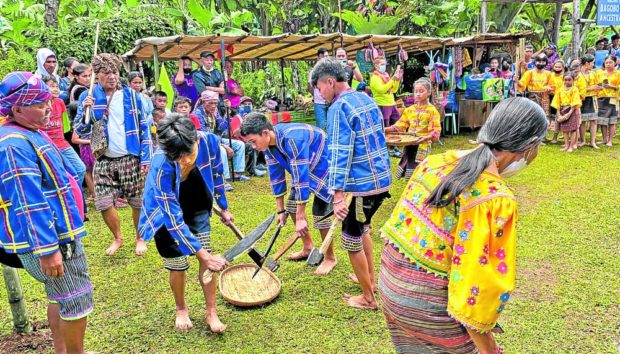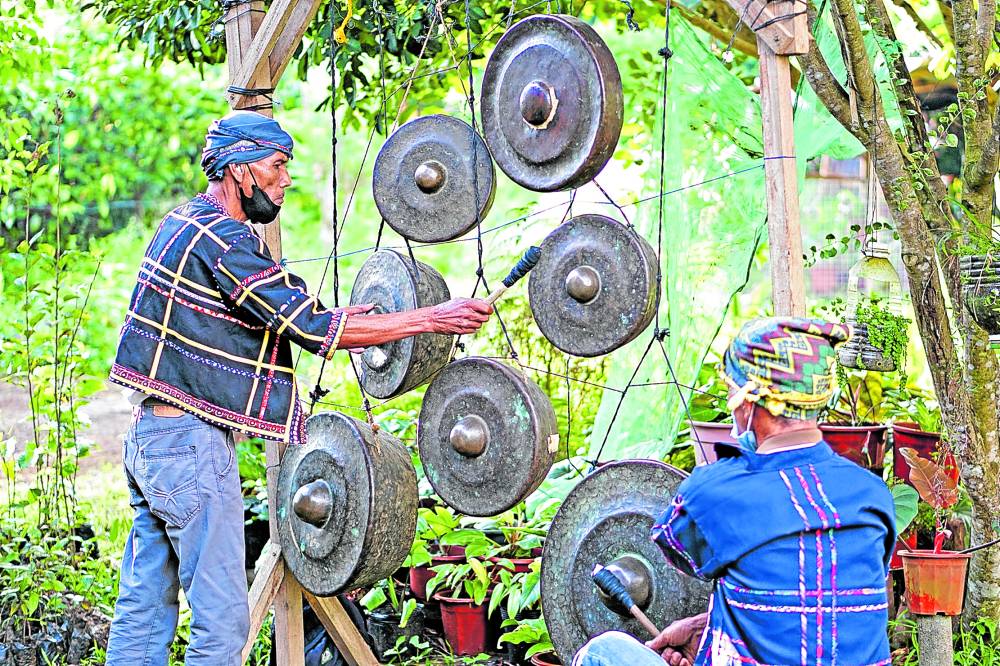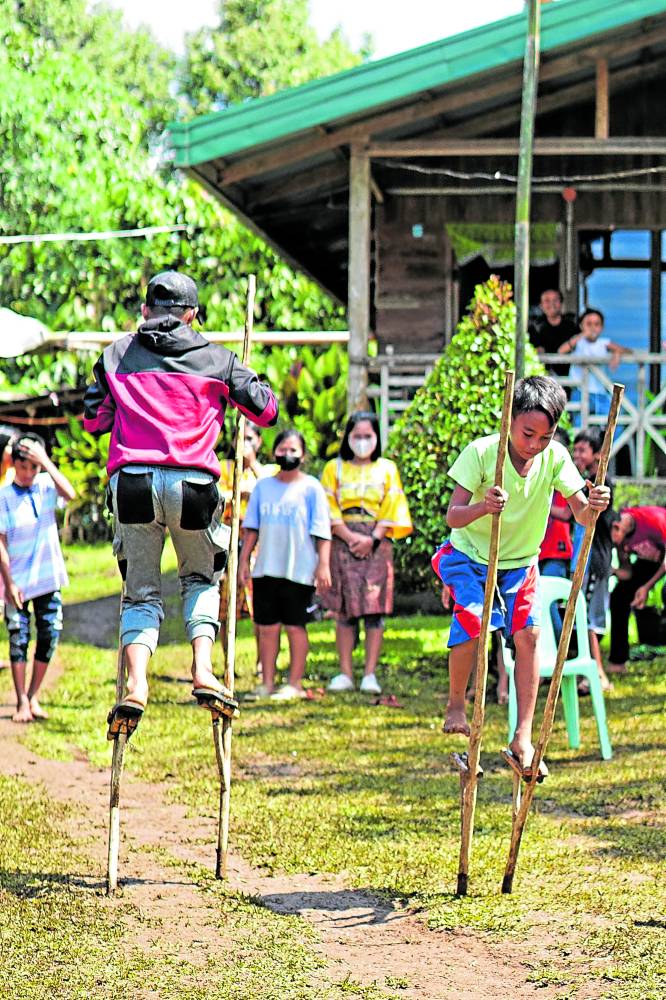Bagobo Klata tribe fights for land, culture, life

TEACHING THE YOUNG Under the watchful eyes of their elders, a group of Bagobo Klata youth performs a traditional dance depicting hunting and gathering for food. The tribe’s elders are stepping up efforts to pass on cultural knowledge to their children. —PHOTOS BY ERWIN M. MASCARIÑAS
D AVAO CITY—For years, the small community of the indigenous Bagobo Klata tribe at the foot of Mt. Apo has been celebrating a festival of thanksgiving for life, rain and the bountiful harvest.
But this year, the elders have a special plea for the spirits to intervene to help preserve and protect their vanishing culture and forest.
Held every second Sunday of October, “Menum” is a feast honoring the earth, the sun and the rain which give life to plants, trees and all the living creatures within their ancestral domain.
It is also a celebration of their culture as the festivity showcases the tribe’s traditional food, music, dances and fun games.
“Our customs and traditions are weaved with nature and the environment, our forest which provides life. Our culture, language and arts remind us of our role as stewards [of nature],” said Pongnguo Rosalito Anog, chieftain of Bol’loy Tattipo Ngo Bagobo Klata (House of Gathering of the Bagobo Klata).

INDIGENOUS SOUND Aging Bagobo Klata musicians hit the kulintang in different intensities to produce melodic beats that bring to life a glorious heritage.
Reverence
Like other tribes living around the country’s highest peak, the Bagobo Klata people revere Apo Sandawa for being the king of the mountains and the Philippine eagle for being the queen of the skies and all birds.
Mt. Apo is thought to be the burial ground of Apo Sandawa, hence, a sacred place for the tribes.
But Anog expressed alarm about the future of this role as many no longer practice the tribal norms and the youth grow up disconnected from their culture.
“We see the life of our children, the next generation, evolve away from this (cultural) path,” Anog lamented.
Many of the tribe’s children are uninitiated to cultural practices as elders died without passing the torch of knowledge to the next generation, Anog noted.
“Many of the children cannot speak our language. This is sad. We fear that one day, our language will just be a recording in time,” he added.

OUTDOOR FUN Children on wooden stilts known as “karang-karang” pass by each other during a two-team relay race, in the same way as their forefathers played outdoors and had fun in their younger years.
Roots
During Menum, the tribe looked back to its roots and its direct relationship with the environment. And everyone was encouraged to speak the Bagobo Klata way.
Anog said that they established a tribal school where parents bring their children every Sunday to learn traditional songs, dance, playing musical instruments, food preparation and the tribe’s dying language.“We, the elders of the tribe, won’t be here in the future. Our future is in the hands of our children,” he pointed out.
Before the festivity started, Anog, joined by other tribal elders, offered a prayer to Mother Earth and Apo Sandawa, invoking their intervention against those who continue to cut the trees within their ancestral domain with wanton disregard for its dire consequences.
“We pray that those who continuously cut trees in the area will be stopped. We hope that the people will think and be enlightened to stop what they are doing as those living in the lowlands will suffer the wrath of Apo Sandawa if no trees will stop floodwaters brought by the rains and the heat from the sun,” the elders said.
The Bagobo Klata tribe owns over 6,378 hectares of forests within the Talomo-Lipadas watersheds of Davao City. Spanning over 25,000 ha, the watersheds host the aquifers from which the water needs of over 1.7 million people in the city are sourced.
The tribe’s ancestral domain also hosts a pair of Philippine eagles.
In 2018, the Philippine Eagle Foundation (PEF) helped the Bagobo Klata come up with their ancestral domain sustainable development and protection plan that embodies their aspirations as a community. During the pandemic, the plan was updated to allow the tribe to cope with the new challenges due to the new coronavirus disease.To prevent them from becoming dependent on forest exploitation to compensate for lost income due to the lockdowns, PEF provided alternative income sources to women-led enterprises.
Indigenous forest guards were also trained and supported to protect the forests from timber poaching, said Dr. Jayson Ibañez, PEF director for research and conservation.
Ibañez reiterated the importance of the festival in promoting environmental conservation together with the conservation of culture and tradition.
“We are reminded of the bounty of natural resources within the ancestral domain and its importance to culture. Without nature and biodiversity, there won’t be indigenous culture, and without culture, human life would be miserable,” Ibañez said.
Symbol
“By using the Philippine eagle as a symbol, the PEF and the Bagobo Klata [tribe] are working together to keep bio-cultural diversity thriving and alive into the future,” added Ibañez.
“The life of the indigenous community is connected with the environment. If you neglect the indigenous peoples, you destroy the environment, and with the environment destroyed, you destroy the life of the people,” said Bishop Valentin Dimoc, national director of the Catholic Bishops’ Conference of the Philippines-Episcopal Commission on Indigenous Peoples, who participated in the Menum.
Dimoc explained that the suffering was brought about by developmental aggressions in the past and that the Church should be there to support and stand steadfast in helping correct the problem.
“The development aggression in the 1960s to 1970s cut through our vast forest, even the home of the Philippine eagle. The sacrifices of everyone should not be overlooked, there should be dialogues to have synodality in caring for each other, let’s restore proper relationship with our environment,” Dimoc said.